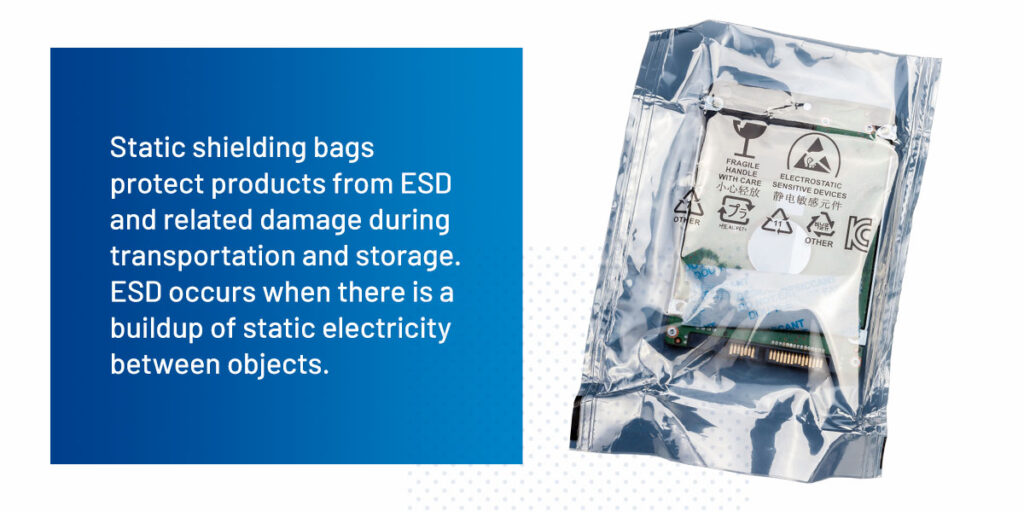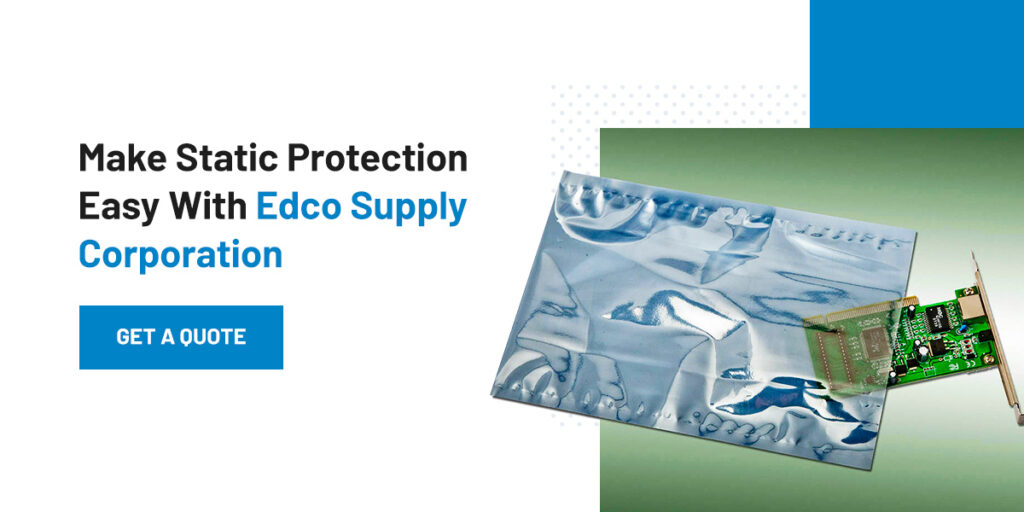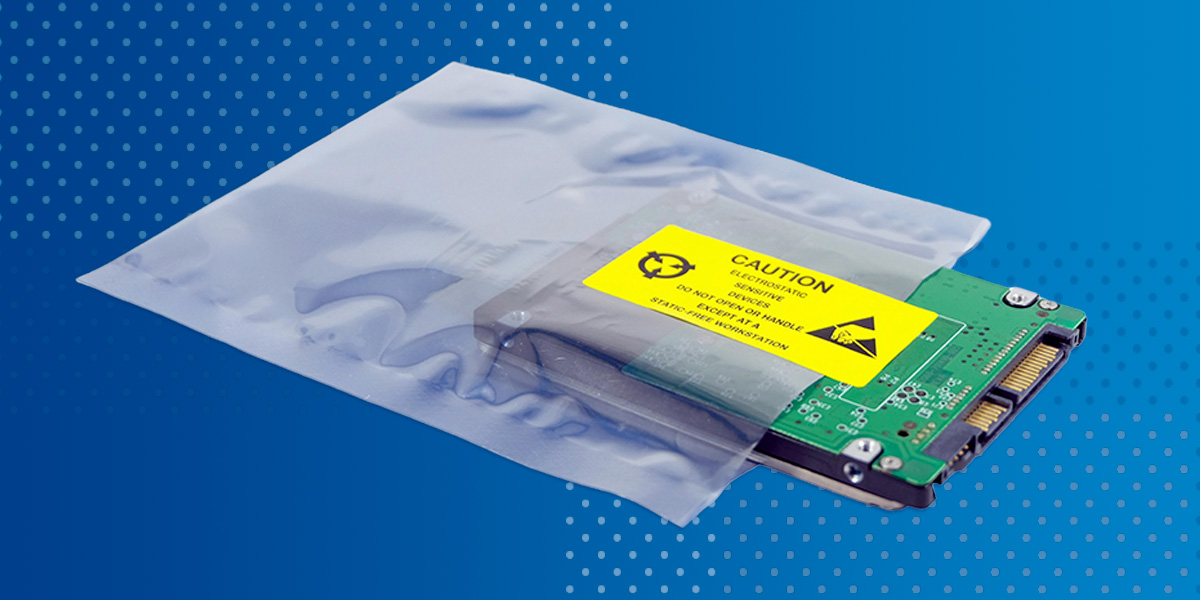Static charges and electricity may seem harmless. They are the small shocks you get after rubbing your socks on the carpet and touching a doorknob or another person — a little jolt and no harm done. However, static electricity and electrostatic discharge (ESD) can damage delicate electronic goods or even cause fires, resulting in thousands of dollars of damage.
Anti-static and static shielding bags are two protective packaging methods that can stop static electricity buildup and prevent ESD damage during transport and shipping.
What Are Anti-Static Bags?
Anti-static bags prevent the buildup of static electricity in goods. They are usually used for delicate products that are vulnerable to electrical damage. Static electricity builds when objects contact each other. Electrons move between the items, causing one to become negatively charged and the other positively charged. This difference in charges results in static electricity.
When static electricity is discharged, it can damage delicate components of electronics, including microprocessors and internal circuits. If enough static electricity is built up and discharged, it can set fire to flammable materials or cause an explosion. Static electricity can remain built up in products and only be released once unloaded or on a shelf.
Anti-Static Bag Materials
Anti-static bags are made from polyethylene terephthalate plastic and special additives. These materials are dissipative, meaning anti-static bags are immune to the transfer of electrons so they don’t hold or generate a charge. Dissipative anti-static bags can also remove or break down any static electricity charge that may have built up. The bags come in various colors, including black, blue and clear, but most anti-static bags are pink. Some are semi-reflective and silver.
Anti-Static Bag Uses
Anti-static bags are used when shipping and storing parts or products sensitive to static electricity. They are also used to transport products that aren’t sensitive to static but are in a static-sensitive environment. Anti-static bags are used in the packaging when transporting and storing physical non-electrical parts used in electronics, such as hard drives, motherboards, chips and other electrical components sensitive to damage from static electricity.
Parts must be placed inside the bag to be protected from static electricity. Anti-static bags don’t protect products from ESD.

What Are Static Shielding Bags?
Static shielding bags protect products from ESD and related damage during transportation and storage. ESD occurs when there is a buildup of static electricity between objects. Static electricity is discharged when objects touch each other again or come in contact with another object. ESD can significantly damage electronics and electrical components.
A static shielding bag acts as a Faraday cage, dissipating the charge by distributing it along the bag. They also prevent any ESD from reaching the components sealed in the bag. Static shielding bags are also anti-static. They have a dissipative coating that stops the buildup of static electricity.
Static Shielding Bag Materials
ESD protection bags are multilayered to create a Faraday cage and give the bags their shielding properties. Most shielding bags have three layers:
- Inner layer: This layer is typically made from static dissipative polyethylene and limits static electricity buildup.
- Middle layer: The middle layer is usually made from carbon or aluminum. It acts as a conductor to collect and ground any charges before they reach the product.
- Outer layer: This layer is made from polyester with a static dissipative coating that removes external electrical charges.
The multiple layers of a static shielding bag mean they can also act as a moisture barrier and prevent oxidation. To work correctly, static shielding bags must be properly sealed. It is essential to avoid puncturing or damaging the layers as this limits the efficacy of the Faraday cage and the dissipative coatings.
Static Shielding Bag Uses
Like anti-static bags, shielding bags are used when transporting products vulnerable to ESD and in environments that are prone to the buildup of static electricity. Unlike anti-static bags, they can protect materials that can catch fire when hit with ESD. Static shielding bags are the safest option for transporting static-sensitive goods.
Static shielding bags are used to transport memory cards, semiconductors, disk drivers, certain explosive or volatile substances, processors and other sensitive electrical components.
Anti-Static vs. Static Shielding Bags
The main difference between static shielding and anti-static bags is how they deal with static charges and ESD. Anti-static bags focus on stopping the buildup of a static electrical charge, but they don’t offer any protection from ESD. Static shielding bags protect goods from internal and external static buildup and ESD.
Which one you decide to use to protect your goods depends on various factors, including where you are sending them, what they are made of and your budget. The U.S. military requires electrical goods and components to be shipped in static shielding materials that are MIL-PRF-81075 compliant.
Static Shielding Bags Advantages and Disadvantages
Static shielding bags come with various benefits. Other than protecting electrical goods and components from static charges and ESD, they also provide a moisture barrier when heat-sealed and can protect products from oxidation. In addition, ESD protection bags can be used in fire prevention. They can stop strong static charges from igniting flammable materials, reducing the potential for fires and explosions.
The main disadvantages of shielding bags include the following:
- They need to be correctly sealed to be effective. Even a tiny gap can cause them to malfunction.
- Extra padding is required for sharp objects to stop them from puncturing the bag.
- They are more expensive than anti-static bags
Anti-Static Bags Advantages and Disadvantages
Anti-static bags are a cost-effective way to stop static charges from building up in goods. If they are thick enough, they can be puncture resistant and provide an additional layer of physical protection to fragile and delicate goods.
The main disadvantage of anti-static bags is that they don’t protect against ESD. They also cannot act as moisture or oxidation protection.

Make Static Protection Easy With Edco Supply Corporation
When choosing between the two bags, you should consider every aspect of transport and storage. If ESD is not a concern, anti-static bags are sufficient protection. They can also help stop the buildup of static electricity in non-electronic parts to reduce the possibility of ESD. A protective packaging solution that strategically uses both bags can help you cost-effectively protect your goods during transport and storage.
As manufacturers of anti-static and static shielding bags, Edco Supply Corporation can help protect your important electrical goods from static electricity and ESD. We manufacture a range of standard sizes and can produce custom sizes up to 50 inches by 200 inches to suit your products.
Look at our range of anti-static and static shielding bags, or request a quote from us today!


